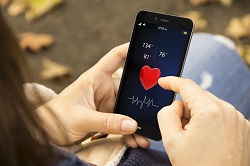A smartphone sensor to smell your breath… and instantly detect disease
Adding sensors to smartphones has been a trend lately, with the newest models being able to detect changes in the likes of temperature, humidity, hand gestures or light. But there is one thing these devices can still not do at this point: analyse our breath. Although portable devices have already been commercialised to detect blood alcohol levels and display it on smartphones, using breath analysis technology to its full potential would be a killer feature for both smartphone manufacturers and app developers. A technology called ‘Na-Nose’ could well be the long-sought-after Holy Grail. Presented in a study published on ACS Nano in December 2016, the device can detect the chemical patterns of exhaled volatile organic compounds (VOCs) in patients’ breath. The new study does not only demonstrate for the first time that specific diseases can be linked to such chemical patterns, but it also shows how Na-Nose can rely on gold nanoparticles and carbon nanotubes to diagnose as many as 17 different diseases including early stage forms of some cancers. Na-Nose’s story began 10 years ago when engineer Hossam Haick joined Technion Israel’s Institute of Technology. There, he started developing a screening tool made up of two parts: a desktop box with a tube into which a person exhales, sending his or her breath into an array of sensors; and an attached computer equipped with machine-learning software and trained to recognise patterns from those sensors. The array’s thin layers of gold nanoparticles or carbon nanotubes are coated with organic ligands. When exhaled VOCs bind to these ligands, the electrical resistance between the nanoparticles or nanotubes is changed. The resulting signal is sent to a computer which uses a pattern-recognition software to determine whether the signal matches that of a particular disease. The device was trained to recognise over 23 illnesses, after which Haick’s team tested it on over 8 000 patients to teach the software how to discriminate between disease and confounding factors, such as contamination, age, gender, background disease and geography. Last year, Haick already demonstrated that the resulting tool could detect gastric cancer in a blinded test of patients with 92-94 % accuracy. But with this new study, he took things even further by using Na-Nose to detect and discriminate among 17 different diseases in the breath of 1 404 individuals across five countries. The next step now consists in miniaturising the device enough to be able to bring it onto smartphones by August 2018, thanks to funding under Horizon 2020’s SNIFFPHONE project. ‘We aim to catch disease at an early stage, where we can increase the survival rate,’ says Haick. For more information, please see: https://www.sniffphone.eu/
Countries
Israel



